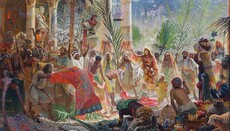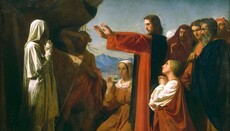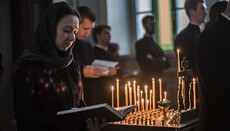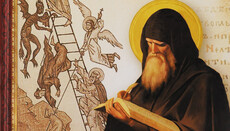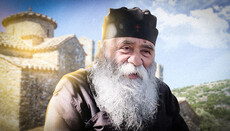Govt’s "experiments” on Caves saints: What holy relics mean for Christians
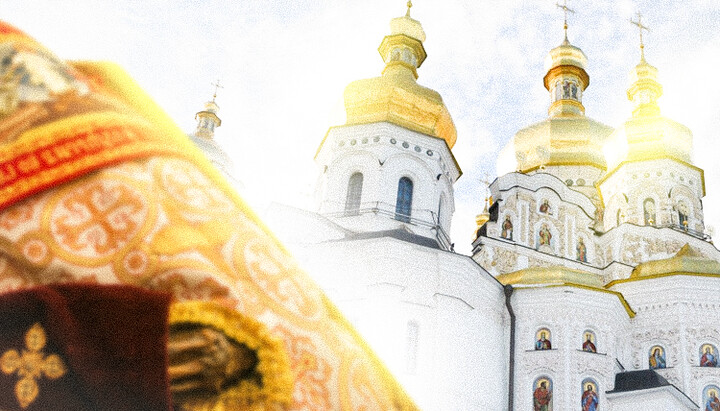
With the campaign to uncover the relics of the Caves saints, it makes sense to reflect on what the relics of saints mean to us and gain insight into the Orthodox teaching about the bodies of the deceased.
On 28 March 2025, a Ministry of Culture commission began its work at the Kyiv-Pechersk Lavra to examine "the presence of the remains of saints in the tombs of the Near and Far Caves" and to determine the "historical and scientific value of the saints' remains."
Since the monks of the Lavra refused to participate in this, the commission members cut the locks with angle grinders and entered the caves.
According to the text of the Minister of Culture’s order to create the commission, information about the work and results of the inspection will be classified. However, one can guess what the commission members plan to do with the relics based on the composition of the participants. There are 25 people in total, but the specialization of some of them stands out. They are biologists, anatomists, embalming specialists, and even veterinarians.
The specializations of these individuals suggest they were invited to conduct certain medical and scientific experiments on the saints’ relics: possibly taking tissue samples and performing other manipulations.
How ethical is all this concerning the Church and the feelings of believers? After all, any Christian in the world will not hesitate to say that all this can be called only in one word – blasphemy.
By the time the article is published, the Ministry of Culture's "scientific research" at the Lavra has been condemned on Mount Athos, in Greece, the USA, by the Serbian and Bulgarian Churches, in Jerusalem, etc.
Almost all of them use words like "sacrilege" and "blasphemy". But why do Christians have such a reverent attitude toward the bodies of saints? In this article, we will try to answer this question.

The Minister of Culture commission on relics examination. Photo: UOJ
The understanding that the remains of a deceased person are not just biological objects but something greater has been known to humanity for millennia. The earliest burials confirm this. For example, the ancient tradition of burying the deceased in an embryonic position is found in many places: Egypt, the United Kingdom (Stonehenge), Ukraine (the Burshtyn burial), and so on. In fact, during certain periods, such as the pre-pharaonic period in Egypt, this method of burial was the most common. It appears that ancient people knew something about the resurrection of the dead and tried to imbue their burials with a specific symbolism, preparing the deceased for a rebirth after death. Numerous other artifacts prove that ancient people knew: life does not end with death.
Biblical accounts of burial practices
The first mention of burial in the Bible is the story of Sarah, Abraham’s wife: “Afterward Abraham buried his wife Sarah in the cave in the field of Machpelah near Mamre (which is at Hebron) in the land of Canaan” (Genesis 23:19). The entire Chapter 23 of Genesis is dedicated to describing these burial rites. Notably, Abraham, who was a stranger in the land of Canaan at the time, insisted on purchasing the cave from the Hittites. The Hittites had great respect for Abraham, sympathized with his loss, and offered him any burial place for free. However, Abraham refused and demanded the “market” price, purchasing the Cave of Machpelah for 400 shekels of silver.
There were later burials in this cave:
- Abraham: “Abraham breathed his last and died… His sons Isaac and Ishmael buried him in the cave of Machpelah near Mamre… in the field Abraham had bought from the Hittites. There Abraham was buried with his wife Sarah” (Genesis 25:8–10).
- Isaac and his wife Rebekah: “In the cave in the field of Machpelah, near Mamre in Canaan, which Abraham bought along with the field as a burial place from Ephron the Hittite. 31 There Abraham and his wife Sarah were buried, there Isaac and his wife Rebekah were buried, and there I buried Leah…” (Genesis 49:30–31).
- Jacob: “So Jacob’s sons did as he had commanded them: 13 They carried him to the land of Canaan and buried him in the cave in the field of Machpelah…” (Genesis 50:12–13).
The forefather Jacob died in Egypt. His twelve sons brought his body to be buried in the Cave of Machpelah and then returned to Egypt, where they had relocated to escape famine. Long before this, eleven of Jacob’s sons had sold their brother Joseph into slavery. He ended up in Egypt, where, after many trials, he became second in command to Pharaoh. When he was dying, Joseph prophesied that God would bring His people out of Egypt and instructed that his bones be taken back to their homeland.
“Then Joseph said to his brothers, ‘I am about to die. But God will surely come to your aid and take you up out of this land to the land he promised on oath to Abraham, Isaac and Jacob.’ And Joseph made the Israelites swear an oath and said, ‘God will surely come to your aid, and then you must carry my bones up from this place.’ So Joseph died at the age of a hundred and ten. And after they embalmed him, he was placed in a coffin in Egypt” (Genesis 50:24–26). These are the final verses of the Book of Genesis. About 400 years later, the Israelites fulfilled this request: “The Israelites went up out of Egypt ready for battle. Moses took the bones of Joseph with him because Joseph had made the Israelites swear an oath. He had said, ‘God will surely come to your aid, and then you must carry my bones up with you from this place’” (Exodus 13:18–19).
Though the Jews held human remains in great reverence and attached importance to burial and everything connected with it, the remains themselves were considered unclean, and touching them was a defilement. “Whoever touches the dead body of anyone shall be unclean for seven days” (Numbers 19:11). This attitude towards the remains was affirmed by Christ Himself in His denunciatory speech against the Pharisees: “Woe to you, scribes and Pharisees, hypocrites! For you are like whitewashed tombs, which indeed appear beautiful outwardly, but inside are full of dead men’s bones and all uncleanness” (Matthew 23:27). One detail stands out: tombs, that is, the caves where the dead were buried, were painted as a sign of respect for the deceased.
In both the Old Testament and modern Judaism, the disinterment, cremation, relocation of remains, or any other actions upon them are prohibited unless absolutely necessary.
Theologically, this is explained on the one hand by respect for the body as the bearer of the soul and as a creation of God, and on the other hand, by the understanding that once the soul departs from the body, it loses the presence of life and, consequently, becomes unclean.
The burial of Christ Himself was accompanied by traditional rituals: “Joseph took the body, wrapped it in a clean linen cloth, 60 and placed it in his new tomb that he had cut out of the rock. He rolled a big stone in front of the entrance to the tomb and went away.” (Matthew 27:59–60). “So they took the body of Jesus and bound it in linen cloths with the spices, as is the burial custom of the Jews” (John 19:40).
The resurrection of Christ in the flesh, the descent of the Holy Spirit upon the apostles, and through them upon all Christians, as well as the ability to partake in the Body and Blood of Christ in the Sacrament of Communion, all of this profoundly influenced the attitude of the faithful toward human remains. They ceased to be viewed as unclean, and touching them could no longer defile. On the contrary, the remains of holy martyrs became objects of veneration, through which the Lord works out miracles and healings.
Veneration of relics in the New Testament Church
The veneration of the saints’ relics began as early as the Apostolic period. The first surviving mention of this is in the work “The Martyrdom of Polycarp” (circa 155–160 AD). It says the following: “We took his bones, more precious to us than expensive stones and purer than gold, and placed them in a worthy place. And, gathering there, we will, as far as possible, joyfully celebrate the birthday of the martyr – in memory of those who fought before us….” In this account, we already see how Christians not only honor the remains of Bishop Polycarp of Smyrna but also gather at his burial site for prayer.
In the Roman catacombs, where the early Christian community generally held services, there are inscriptions dated the 2nd and 3rd centuries marking the burial places of martyrs. It is known that from this time, a tendency developed among wealthy and noble Christians to be buried near martyrs. Although this may not be entirely correct from a spiritual perspective, the mere fact indicates that the relics of saints were revered in the Church.
St. Irenaeus of Lyons (circa 180 AD), in his book “Against Heresies”, wrote: “As some say, the martyrs are better than others because they are vessels of the Spirit, and therefore they should be venerated…” This testimony shows that the veneration of martyrs was already a widespread practice at that time. And Irenaeus acknowledges that this was right.
In the 3rd century, the practice of holding services at the tombs of martyrs became even more widespread. Burial near saints developed into a privileged tradition. The literary monument of 203 AD, known as “The Passion of Perpetua and Felicitas”, contains the following passage: “We sought a place for our burial, as a revelation of the future… We saw in the Spirit that our brother Saturninus went ahead of us, as if seeking a place for our burial….” This indicates that Christians considered it very important where they were buried.
In the 4th century, the veneration of relics became public and gained even more widespread acceptance. This was largely facilitated by the Edict of Milan in 313 AD, which established freedom of religion: “We might grant to the Christians and to all others full authority to observe that religion which each preferred; whence any Divinity whatsoever in the seat of the heavens may be propitious and kindly disposed to us and all who are placed under our rule.”
By this time, the first mentions of the solemn transfer of relics to churches can be found. For example, in 357 AD, the relics of the holy apostles Andrew and Luke were transferred to Constantinople. Many authors from this period describe the veneration of relics as a widespread and ancient practice:
- St. John Chrysostom: “The bones of the martyrs shine like stars; the demons tremble, diseases vanish.”
- St. Basil the Great: “The dust of the martyr sanctifies the earth… His bones exude grace… We honor the memory of the martyrs, touch their relics, and receive blessings.”
- St. Gregory the Theologian: “I honor the relics of the martyrs to partake in holiness through them.”
- Eusebius of Caesarea: “The people gathered on the day of the martyrdom… at their burial sites to honor their memory and celebrate the Eucharist.”
In later centuries, mentions of the veneration of relics in the works of Church writers became increasingly frequent. The theological justification for such veneration emerged, centered on the idea that the Holy Spirit sanctifies the whole person, both soul and body. Upon death, the soul separates from the body, but the Holy Spirit remains present in both the soul and the body.
For example, St. Gregory the Great (6th century) wrote: “God glorifies the relics of His saints, showing that He remains with them even after death.”
The grace of the Holy Spirit, abundantly acquired by the saints during their lives, shines through their relics even after death. St. John Chrysostom wrote: “The bodies of the saints, though they have died, remain filled with grace, just as they were during their lives, and sometimes even more so.”
By the 8th-9th centuries, there are references to the practice of placing relics in antiminses. The practice of Christian pilgrimages to the places of martyrdom and burial of saints spread. Some local councils approved this practice by their decrees.
The theological foundation for the veneration of relics was finalized at the 7th Ecumenical Council (787 AD). The acts of this Council state:
- “We lovingly venerate the holy and precious icons, as well as the holy relics of the saints, which are full of grace and blessing.”
- “We venerate the holy relics of the martyrs, for through them God performs healings and miracles.”
In the theology of relics veneration, as fixed by the decrees of the 7th Ecumenical Council, there are three key points. First, relics may be objects of veneration (Greek: “δουλεία”), but not worship (Greek: “λατρεία”), which belongs to God alone. Second, the veneration of relics is based on the belief in the deification of the flesh, the resurrection, and the sanctification of the material world by the Spirit. Third, the rejection of relics (as well as icons) is recognized as heresy and a violation of the apostolic tradition.
What does disrespect toward holy relics mean?
Iconoclasm, which was finally defeated at the 7th Ecumenical Council, was essentially a denial of the incarnation of the Word of God. In the Old Testament Judaism, there was a prohibition against images of God, as the invisible and unknowable could not be depicted. However, the coming of Jesus Christ into the world, the Son of God and the Son of Man, allowed us to see Him with our bodily eyes, and thus to depict Him.
The Apostle John wrote in the Gospel: “No one has ever seen God, but the one and only Son, who is himself God and[a] is in closest relationship with the Father, has made him known” (John 1:18). In another place, he records a conversation between Christ and His disciple: “Philip said, ‘Lord, show us the Father and that will be enough for us.’ Jesus answered: ‘Don’t you know me, Philip, even after I have been among you such a long time? Anyone who has seen me has seen the Father. How can you say, ‘Show us the Father’?” (John 14:8–9).
If iconoclasm, which manifested itself in the denial of the holiness of icons and the disrespectful attitude towards them, or, in simple terms, desecration, denied the dogma of the incarnation of the Word of God, then
the denial of the holiness of the relics of God’s servants, the sacrilegious attitude towards them as objects for scientific study, dissection, and so on – is a denial of the dogma of the deification of man by the grace of the Holy Spirit.
The Apostle Paul wrote to the Corinthians: “Do you not know that your bodies are temples of the Holy Spirit, who is in you, whom you have received from God? You are not your own?” (1 Cor. 6:19). This attitude toward the body of the Christian man is expressed in the veneration of his remains after death. Even with the bodies of ordinary deceased individuals, we show respect. For example, even among non-believers, it is customary to remove one’s headgear in front of the coffin of the deceased. However, when it comes to holy people who, through their martyrdom or ascetic life, acquired an abundant grace of the Holy Spirit, disrespectful treatment of their relics is nothing less than a denial of their deification, a denial of the fact that the Holy Spirit works in our world.
St. Nikolai of Serbia wrote: “The holy relics are proof that a person can become the temple of the Holy Spirit, not only in the soul but also in the body.”
What is happening now at the Kyiv Pechersk Lavra, the exhumation of the relics of the saints without any reverence, prayer, or veneration, their scientific examination by veterinarians, embryologists, histologists, and other specialists, as well as the determination of their scientific and cultural value by people far from Orthodoxy, is nothing other than a denial of the dogma of the Holy Spirit and His work in man.
